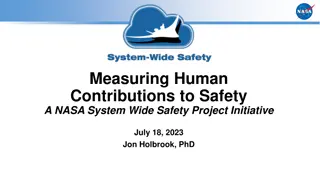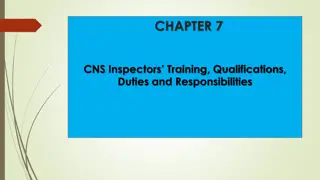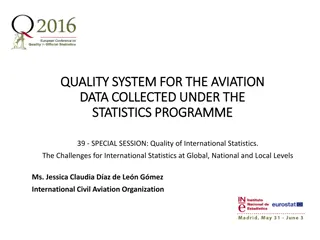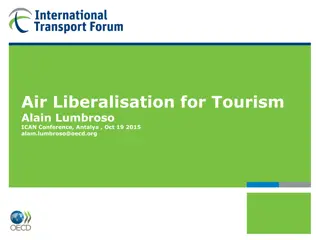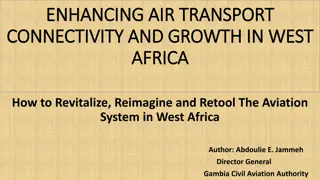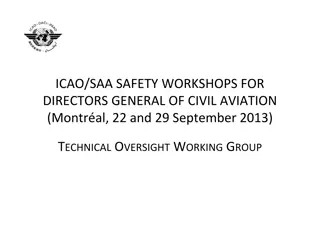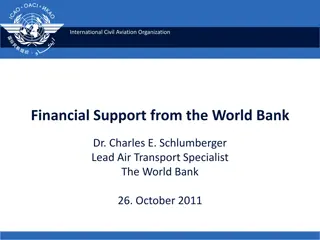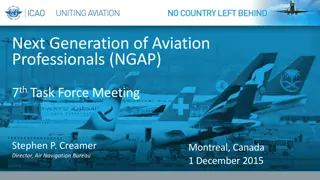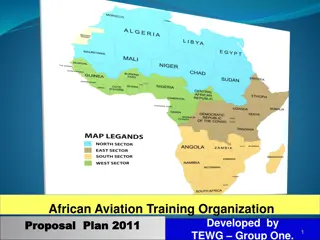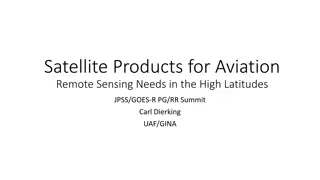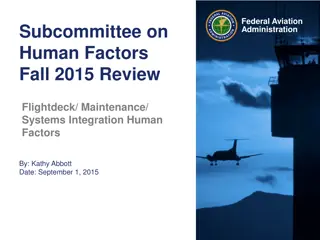Enhancing Aviation Safety with Advanced Communication Networks in Africa
Aviation safety in Africa has been improved through the implementation of advanced communication networks like the SADC/1 and NAFISAT. These networks have replaced outdated infrastructure, allowing for reliable Air Traffic Services and data transmission. The initiative led by ATNS and IATA has significantly enhanced aeronautical telecommunications in the region.
Download Presentation

Please find below an Image/Link to download the presentation.
The content on the website is provided AS IS for your information and personal use only. It may not be sold, licensed, or shared on other websites without obtaining consent from the author.If you encounter any issues during the download, it is possible that the publisher has removed the file from their server.
You are allowed to download the files provided on this website for personal or commercial use, subject to the condition that they are used lawfully. All files are the property of their respective owners.
The content on the website is provided AS IS for your information and personal use only. It may not be sold, licensed, or shared on other websites without obtaining consent from the author.
E N D
Presentation Transcript
Agenda Item Agenda Item 9.1.5 ITU WRC 9.1.5 ITU WRC- -15 15 Presented by Koos Pretorius, SACAA Regional Frequency Spectrum Workshop for ITU WRC-15 Lima, Peru March 11-12, 2013
WRC-15 Agenda Item 9.1 5 (9.1.5); Consideration of technical and regulatory actions in order to support existing and future operation of fixed-satellite stations within the band 3 400 4 200 MHz, as an aid to the safe operation of aircraft and reliable distribution information in some countries in Region 1 (Resolution 154 (WRC-12)) service earth of meteorological
Historic Background Aviation safety across the African Continent has been compromised by a lack of reliable fixed aeronautical telecommunications infrastructure used for providing Air Traffic Services/Direct Speech ( ATS/DS ) and Aeronautical Fixed Telecommunications Network ( AFTN ) voice and data services The South African Air Navigation Service Provider, Air Traffic and Navigation Services (ATNS) in collaboration with the International Air Travel Association (IATA) introduced the Southern African Development Community (SADC) Very Small Aperture Terminal (VSAT) network in the Fixed Satellite Service (FSS) C-Band in 1998 called SADC/1
When the SADC/1 VSAT network reached its end- of-life it became imperative to replace the network due to maintenance costs, and in particular the repair of VSAT equipment that became unaffordable as the basic VSAT technology platform was not supported anymore. As part of the on going support of aeronautical and navigational services in the SADC region, ATNS and the individual States therefore collectively decided to replace the SADC VSAT network with a new baseline VSAT technology platform that will provide and support legacy as well as new communications facilities and protocols. (The SADC/2 network)
As a result of the leading role ATNS played in resolving the aeronautical fixed communication deficiencies in the SADC Region, ICAO and the North East African States accepted an offer from ATNS and IATA to implement a similar fixed aeronautical VSAT network in the North East AFI (Africa-Indian Ocean) Region, to address the ATS/DS and AFTN deficiencies within this region. (The NAFISAT network)
The SADC/2 and NAFISAT VSAT networks are supported by ATNS in terms of the bilateral agreements reached with all the States in the SADC and North East African regions. Not all the individual Sates have the capability to maintain their in-country VSAT terminals, and as a result of the high availability and maintainability requirements, 2 (two) Maintenance Management Centres were established to co-ordinate fault and failure management. These centres are also responsible for physical maintenance site visits to those sites that do not at present have their own maintenance capability.
The two main centres are: Entebbe, serving mainly the States in the North East African Region and; Johannesburg, serving mainly the States in the SADC Region. These two centres also provide the master timing for the TDMA signals to the network. Additional Multi-Channel per Carrier ( MCPC ) point-to-point links are provided in the SADC and NAFISAT VSAT network for interconnection to the ASECNA ( Agency for the Safety of Aerial Navigation in Africa ) AFISNET ( Africa Indian Ocean Satellite Network ) VSAT network operated in West Africa.
ATNS VSAT NETWORK: NAFISAT and SADC/2 - ATS/DS Connectivity Tunis Tripoli 16 Cairo MID Region 16 16 16 16 16 Jeddah 16 16 Asmara 16 16 Dakar Khartoum 16 Niamey 16 16 Sana'a 16 16 16 16 N'Djamena Djibouti 16 16 Mumbai 16 16 Addis Ababa 16 16 16 Abijan Accra 16 16 16 Bangui 16 Mogadishu 16 16 16 16 Entebbe 16 16 16 16 Brazzaville Kigali 16 Victoria (Seychelles) Nairobi 16 16 16 16 Bujumbura 16 16 16 16 Kinshasa 16 16 16 Dar es Salaam 16 16 16 16 Luanda 16 16 16 16 16 Lilongwe Lusaka 16 16 16 16 16 16 Antananarivo 16 16 16 16 16 Harare Beira Planned NAFISAT Circuits 16 16 16 16 Plaisance (Mauritius) 16 16 16 16 16 Windhoek Gaborone 16 Future Planned NAFISAT Circuits 16 16 16 Maputo Johannesburg 16 Manzini 16 Planned SADC/2 Circuits 16 16 Maseru Future Planned SADC/2 Circuits 16 Planned MCPC Circuits 16 Future Planned MCPC Circuits 16 Planned shared circuits between NAFISAT and SADC/2 16 Revision 1.5 28-11-06
ATNS VSAT NETWORK NAFISAT and SADC/2 - AFTN Connectivity Tunis Tripoli Cairo 9.6 MID Region 9.6 9.6 9.6 9.6 Jeddah 9.6 9.6 Asmara 9.6 Dakar Niamey 9.6 Khartoum Sana'a 9.6 9.6 9.6 N'Djamena Djibouti 9.6 9.6 Mumbai 9.6 Addis Ababa Bangui Abijan Accra 9.6 Mogadishu 9.6 9.6 Entebbe 9.6 9.6 Brazzaville Kigali 9.6 9.6 Nairobi Victoria (Seychelles) 9.6 9.6 Bujumbura Kinshasa 9.6 9.6 Dar es Salaam 9.6 Luanda 9.6 9.6 9.6 9.6 Lilongwe Lusaka 9.6 Planned NAFISAT Circuits 9.6 Antananarivo 9.6 9.6 Harare Future Planned NAFISAT Circuits Beira 9.6 9.6 9.6 Plaisance (Mauritius) Gaborone 9.6 9.6 Windhoek 9.6 Planned SADC/2 Circuits 9.6 9.6 Maputo Johannesburg 9.6 Manzini 9.6 Future Planned SADC/2 Circuits 9.6 9.6 Maseru Planned MCPC Circuits 9.6 Future Planned MCPC Circuits 9.6 Planned shared circuits between NAFISAT and SADC/2 9.6 Revision 1.4 09-10-06
These VSAT networks support all aeronautical communications services including the extension of VHF aeronautical mobile, navigation and surveillance. VSAT networks are also used for data links for the meteorological services in Africa Today, infrastructure, spanning the entire African continent and beyond. The availability of the entire 3.4 to 4.2 GHz FSS band is crucial for the AFI Region to ensure the continued growth of traffic while maintaining the required level of safety in this region. VSAT networks constitute a real
The Issue Agenda Item 1.4 at the World Radio Conference of 2007 (WRC-07), addressed the issue whether the band 3400 MHz to 4200 MHz ( C-band ) should be identified for the International Mobile Telecommunications (IMT) on a global basis with the longstanding primary allocation to the fixed satellite service (FSS) WRC-07 rejected the global identification for IMT in the C-band because of the recognised need to protect FSS communications from harmful interference evidenced in studies by the ITU
WRC-07, subject to certain restrictions, adopted new footnotes to Radio Regulations to allow the band 3400MHz to 3600MHz for use by the IMT, but only by countries listed in the foot notes (opt-in countries. The restrictions established additional protection for the C-band earth stations by the opt-in countries in each of the three ITU regions. 81 Counties in Region 1 opt-in and the band 3400- 3600MHz was allocated and became effective in November 2010 on a co-primary basis for the mobile (including IMT ) with PDF limit restrictions and coordination requirements
In the 14 opt-in countries in Region 2, the 3400 MHz 3500 MHz band was allocated by footnote to mobile services (which includes IMT) on a co- primary basis subject to coordination with affected administrations The 3500 MHz 3600 MHz band has also been identified for IMT in opt-in countries in Region 3. *Since the effective date, interference interruptions have occurred throughout Africa, and in Australia, Bolivia, the Caribbean, China, Fiji, Hong Kong, Indonesia and Russia. *Source - Squire, Sanders & Dempsey L.L.P.
CONCLUSION Regulatory measures are needed to ensure an appropriate level of protection for the FSS C-band spectrum which is used to augment terrestrial communication networks through the use of VSAT technology. VSAT technology is used to facilitate safety of life CNS services within the aeronautical community. Long-term VSAT spectrum availability and protection from interference should be guaranteed across the entire African Continent and other parts of the world. The meeting is invited to support the following recommendation: .
Recommendation Long-term very small aperture terminal spectrum availability and protection: a) that ICAO Member States should not support additional international mobile telecommunications spectrum allocation in the fixed satellite services C- band spectrum at the expense of the current or future aeronautical very small aperture terminal networks; and b) ICAO and ICAO Member States to pursue this matter in ITU-R and during the World Radio Conference (WRC-15, Agenda Items 1.1 and 9.1.5), to prevent any international mobile telecommunications spectrum allocation that compromises the availability of the aeronautical very small aperture terminal networks





